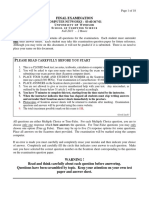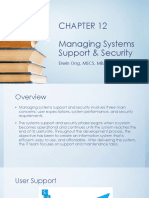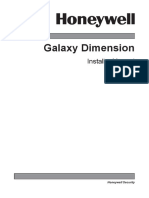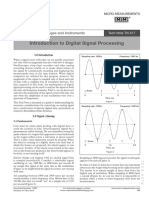Chapter 15 Quizzes
Chapter 15 Quizzes
Uploaded by
Amal SamuelCopyright:
Available Formats
Chapter 15 Quizzes
Chapter 15 Quizzes
Uploaded by
Amal SamuelOriginal Description:
Copyright
Available Formats
Share this document
Did you find this document useful?
Is this content inappropriate?
Copyright:
Available Formats
Chapter 15 Quizzes
Chapter 15 Quizzes
Uploaded by
Amal SamuelCopyright:
Available Formats
1 CHAPTER 15
1 Which of the following statements about wired and wireless LANs is correct?
A) Both operate in the lower two layers of the TCP/IP protocol suite.
B) Wired LANs operate in the lower two layers and wireless LANs operate in the lower
three layers of the TCP/IP protocol suite.
C) Wired LANs operate in the lower three layers and wireless LANs operate in the lower
two layers of the TCP/IP protocol suite.
D) Both operate in the lower three layers of the TCP/IP protocol suite.
2 IEEE has defined the specifications for a wireless LAN, called _______, which covers the
physical and data-link layers.
A) IEEE 802.3
B) IEEE 802.5
C) IEEE 802.11
D) IEEE 802.2
3 The CSMA/CD algorithm does not work in wireless LAN because
A) wireless host does not have enough power to work in a duplex mode.
B) of the hidden station problem.
C) signal fading could prevent a station at one end from hearing a collision at the other
end.
D) all of the choices are correct.
4 In IEEE 802.11, a ___ is made of stationary or mobile wireless stations and an optional
central base station, known as the access point (AP).
A) ESS
B) BSS
C) CSS
D) None of the choices are correct
5 In IEEE 802.11, a BSS without an AP is called _________.
A) an ad hoc architecture
B) an infrastructure network
C) either an ad hoc architecture or an infrastructure network
D) None of the choices are correct
CREATED BY SAHAR SALEM
2 CHAPTER 15
6 In IEEE 802.11, a BSS with an AP is sometimes referred to as ____________.
A) an ad hoc architecture
B) an infrastructure network
C) either an ad hoc architecture or an infrastructure network
D) None of the choices are correct
7 In IEEE 802.11, communication between two stations in two different BSSs usually
occurs via two ________.
A) BSSs
B) ESSs
C) APs
D) None of the choices are correct
8 In IEEE 802.11, a station with ________ mobility is either stationary (not moving) or
moving only inside a BSS.
A) no-transition
B) BSS-transition
C) ESS-transition
D) None of the choices are correct
9 In IEEE 802.11, a station with ________mobility can move from one BSS to another, but
the movement is confined inside one ESS.
A) no-transition
B) BSS-transition
C) ESS-transition
D) None of the choices are correct
10 In IEEE 802.11, a station with ________ mobility can move from one ESS to another.
A) no-transition
B) BSS-transition
C) ESS-transition
D) None of the choices are correct
CREATED BY SAHAR SALEM
3 CHAPTER 15
11 In IEEE 802.11, distributed coordination function (DCF) uses _______ as the access
method.
A) CSMA/CA
B) CSMA/CD
C) ALOHA
D) None of the choices are correct
12 In IEEE 802.11, when a frame is going from one station in a BSS to another station in
the same BSS, the address flag is _____.
A) 00
B) 01
C) 10
D) 11
13 In IEEE 802.11, when a frame is coming from an AP and going to a station, the address
flag is _______.
A) 00
B) 01
C) 10
D) 11
14 In IEEE 802.11, when a frame is going from a station to an AP, the address flag is _____.
A) 00
B) 01
C) 10
D) 11
15 In IEEE 802.11, when a frame is going from one AP to another AP in a wireless
distribution system, the address flag is _____.
A) 00
B) 01
C) 10
D) 11
CREATED BY SAHAR SALEM
4 CHAPTER 15
16 In IEEE 802.11, the access method used in the PCF sublayer is ______.
A) contention
B) controlled
C) polling
D) None of the choices are correct
17 In IEEE 802.11, the ______ is a time period used for collision avoidance.
A) NAV
B) BSS
C) ESS
D) None of the choices are correct
18 In IEEE 802.11, the addressing mechanism can include up to ______addresses.
A) four
B) five
C) six
D) None of the choices are correct
19 The original IEEE 802.11 uses _________.
A) FHSS
B) DSSS
C) OFDM
D) either FHSS or DSSS
20 The IEEE 802.11a uses _________.
A) FHSS
B) DSSS
C) OFDM
D) either FHSS or DSSS
21 The IEEE 802.11b uses _________.
A) FHSS
B) DSSS
C) OFDM
D) either FHSS or DSSS
CREATED BY SAHAR SALEM
5 CHAPTER 15
22 The IEEE 802.11g uses _________.
A) FHSS
B) DSSS
C) OFDM
D) either FHSS or DSSS
23 The IEEE 802.11 FHSS uses ______ modulation.
A) ASK
B) FSK
C) PSK
D) None of the choices are correct
24 The IEEE 802.11 or IEEE 802.11b DSSS uses ______ modulation.
A) ASK
B) FSK
C) PSK
D) None of the choices are correct
25 The IEEE 802.11a, IEEE 802.11g, or IEEE 802.11n OFDM uses ______ modulation.
A) ASK
B) FSK
C) PSK
D) None of the choices are correct
26 Bluetooth is a _______ technology that connects devices (called gadgets) in a small
area.
A) wired LAN
B) wireless LAN
C) VLAN
D) None of the choices are correct
27 In Bluetooth, multiple ________ form a network called a _________.
A) scatternet; piconets
B) piconets: scatternet
C) piconets: bluenet
D) bluenet; scatternet
CREATED BY SAHAR SALEM
6 CHAPTER 15
28 A Bluetooth network consists of _____ primary device(s) and up to ____ secondary
devices.
A) one; five
B) five; three
C) two; six
D) one; seven
29 In Bluetooth, the current data rate is ____Mbps.
A) 2
B) 5
C) 11
D) None of the choices are correct
30 The access method in Bluetooth is ________.
A) FDMA
B) TDD-TDMA
C) CDMA
D) None of the choices are correct
31 In Bluetooth, the _____ link is used when data integrity is more important than avoiding
latency.
A) SCO
B) ACL
C) ACO
D) SCL
32 Bluetooth uses ______ in the physical layer to avoid interference from other devices or
other networks.
A) DSSS
B) FHSS
C) FDMA
D) None of the choices are correct
CREATED BY SAHAR SALEM
You might also like
- Data Communications & NWKSDocument10 pagesData Communications & NWKSdiprodserv nigltdNo ratings yet
- Telecommunications, The Internet, and Wireless TechnologyDocument22 pagesTelecommunications, The Internet, and Wireless TechnologyshanerNo ratings yet
- 4.2.2.7 Lab - Building An Ethernet Crossover CableDocument6 pages4.2.2.7 Lab - Building An Ethernet Crossover Cablerezhablo100% (2)
- CH 15 Connecting LANs Backbone Networks and Virtual LANs Multiple Choice Questions Answers MCQ PDFDocument12 pagesCH 15 Connecting LANs Backbone Networks and Virtual LANs Multiple Choice Questions Answers MCQ PDFraghad mejeedNo ratings yet
- Forouzan: MCQ in Introduction To Data Communications and NetworkingDocument28 pagesForouzan: MCQ in Introduction To Data Communications and NetworkingMc King Stephen NagutomNo ratings yet
- Wired Lans Ethernet MCQ and ExercisesDocument5 pagesWired Lans Ethernet MCQ and ExercisesEllaineMaeCasilaganNo ratings yet
- Forouzan MCQ in Network Models Set 1Document10 pagesForouzan MCQ in Network Models Set 1Froyd WessNo ratings yet
- Chap 8 - Wireless LANsDocument35 pagesChap 8 - Wireless LANsAmirul IkwanNo ratings yet
- Chapter-21 Multicast RoutingDocument29 pagesChapter-21 Multicast RoutingjeyavinothaNo ratings yet
- Unit 5.4 SNMPDocument15 pagesUnit 5.4 SNMPSUMIT PANDEYNo ratings yet
- ITT542 - Case Study 1 Network Layer Protocol ORIDocument10 pagesITT542 - Case Study 1 Network Layer Protocol ORIAhmad KamalNo ratings yet
- Data Communication and Networking CHDocument39 pagesData Communication and Networking CHUzair KhanNo ratings yet
- Acn-6 1Document26 pagesAcn-6 1Maysam AlkeramNo ratings yet
- FCN SampleDocument5 pagesFCN SampleRoshun GeorgeNo ratings yet
- University of Management and Technology: Mid Term ExamDocument7 pagesUniversity of Management and Technology: Mid Term ExamMuneeb Ahmad100% (2)
- CH 02Document27 pagesCH 02Petter PNo ratings yet
- Networking & Data CommunicationDocument30 pagesNetworking & Data CommunicationMR PAINTERNo ratings yet
- Chapter 15 W AnswerDocument2 pagesChapter 15 W AnswerjessdoriaNo ratings yet
- CH - 17, Connecting DevicesDocument42 pagesCH - 17, Connecting DevicesSaleha FarooqNo ratings yet
- EC6802 Wireless Networks Important PART-A &B Questions With AnswersDocument21 pagesEC6802 Wireless Networks Important PART-A &B Questions With AnswersohmshankarNo ratings yet
- Chapter 27: Ipv6 ProtocolDocument29 pagesChapter 27: Ipv6 ProtocolRaghu Vamsi PotukuchiNo ratings yet
- SNMPv1 Network Management Organization and Information ModelsDocument52 pagesSNMPv1 Network Management Organization and Information Modelsjames macalaladNo ratings yet
- The Internet Protocol Version 4 (Ipv4) Is The Delivery Mechanism Used by The Tcp/Ip ProtocolsDocument25 pagesThe Internet Protocol Version 4 (Ipv4) Is The Delivery Mechanism Used by The Tcp/Ip ProtocolsChhaya NayakNo ratings yet
- VoIP Based Tele-Medicine Call Center-IssuesDocument9 pagesVoIP Based Tele-Medicine Call Center-IssuesRio IrmayantoNo ratings yet
- 367 Final Fall 2013 AnswersDocument18 pages367 Final Fall 2013 AnswersMona Ali100% (1)
- Laboratory Activity Firewall IDS EncryptionDocument4 pagesLaboratory Activity Firewall IDS Encryptionjpermano24No ratings yet
- Lecture 8Document23 pagesLecture 8ngabo bonckNo ratings yet
- The Evolution and Future of Wired CommunicationsDocument2 pagesThe Evolution and Future of Wired CommunicationsHubert SemenianoNo ratings yet
- Bluetooth Interview Questions and AnswersDocument7 pagesBluetooth Interview Questions and AnswerssilkybhatiaNo ratings yet
- TOPIC - 1 MicroprocessorDocument38 pagesTOPIC - 1 MicroprocessorPrevenaManiamNo ratings yet
- Compare and Contrast A Conventional Signature and A Digital SignatureDocument5 pagesCompare and Contrast A Conventional Signature and A Digital SignatureVikram KumarNo ratings yet
- HCT 207 Final ExamS 2019 May-JuneDocument6 pagesHCT 207 Final ExamS 2019 May-JuneMarlon Tugwete100% (1)
- Computer Networks and Security LaboratoryDocument1 pageComputer Networks and Security Laboratoryprince_kc2002No ratings yet
- Network Layer Logical AddressingDocument31 pagesNetwork Layer Logical AddressingmaheshNo ratings yet
- Review Questions: Identify The Five Components of A Data Communications System?Document46 pagesReview Questions: Identify The Five Components of A Data Communications System?DARIUSNo ratings yet
- Chap-27 Next Generation IPv6Document65 pagesChap-27 Next Generation IPv6sukujeNo ratings yet
- Network LayerDocument76 pagesNetwork LayerTalha Hussain BhuttoNo ratings yet
- MTCS 202 WMN QBDocument52 pagesMTCS 202 WMN QBArun SharmaNo ratings yet
- Freedom of ExpressionDocument20 pagesFreedom of ExpressionRamil NacarioNo ratings yet
- Optical CommunicationDocument10 pagesOptical CommunicationYashasvi MittalNo ratings yet
- Signaling (Telecommunications) : ClassificationDocument3 pagesSignaling (Telecommunications) : ClassificationAqsa LiaqatNo ratings yet
- Facial Recognition Using LabVIEWDocument2 pagesFacial Recognition Using LabVIEWAnjali Naidu33% (3)
- PSTNDocument33 pagesPSTNSatish Kumar KarnaNo ratings yet
- PHASE 5 - Chapter 12 Managing Systems Support & SecurityDocument34 pagesPHASE 5 - Chapter 12 Managing Systems Support & Securityscm39100% (2)
- Syllabus Computer NetworkDocument2 pagesSyllabus Computer NetworkVishal JainNo ratings yet
- DSL & Its TypesDocument24 pagesDSL & Its TypesahmedNo ratings yet
- s6 Ict Revision Questions Guiding Questions Topic 11 Data Communication and NetworkingDocument3 pagess6 Ict Revision Questions Guiding Questions Topic 11 Data Communication and Networkingkaggwa josephNo ratings yet
- 9.1.4.9 Lab - Subnetting Network TopologiesDocument11 pages9.1.4.9 Lab - Subnetting Network TopologiesEdgar RamirezNo ratings yet
- Chapter 13: Multiplexing and Multiple-Access Techniques: True/FalseDocument7 pagesChapter 13: Multiplexing and Multiple-Access Techniques: True/FalseChristopher Inoval ParilNo ratings yet
- Cdot Question BankDocument71 pagesCdot Question BankemseceNo ratings yet
- Malawi I CT ReportDocument40 pagesMalawi I CT ReportWasili Mfungwe100% (1)
- Difference Between Digital Signal Processor (DSP) and Microprocessor (UP)Document10 pagesDifference Between Digital Signal Processor (DSP) and Microprocessor (UP)Aamodh KuthethurNo ratings yet
- Router Vs SwitchDocument2 pagesRouter Vs SwitchKaustubh ParkerNo ratings yet
- Assignment 1 Network SecurityDocument5 pagesAssignment 1 Network SecuritySaeed AhmedNo ratings yet
- NS-2 Lab QuestionsDocument5 pagesNS-2 Lab QuestionsUSHANo ratings yet
- Introduction To Microsoft Excel: ComputerDocument6 pagesIntroduction To Microsoft Excel: ComputerVGNo ratings yet
- Quiz CNDocument47 pagesQuiz CNJoseph Kumar ChowdaryNo ratings yet
- WlanDocument8 pagesWlanAshish Kumar SinghNo ratings yet
- Mobile Comm - Worksheet2Document4 pagesMobile Comm - Worksheet2SUGANYA T 16BCS063No ratings yet
- Chapter 23 QuizzesDocument4 pagesChapter 23 QuizzesAmal Samuel100% (1)
- Chapter 21 QuizDocument5 pagesChapter 21 QuizAmal SamuelNo ratings yet
- It 210 Chapter 18: Created By: Sahar SalemDocument5 pagesIt 210 Chapter 18: Created By: Sahar SalemAmal SamuelNo ratings yet
- It 210 Chapter 19: Created by Sahar SalemDocument4 pagesIt 210 Chapter 19: Created by Sahar SalemAmal SamuelNo ratings yet
- It210 Chapter 20: Created by Sahar SalemDocument4 pagesIt210 Chapter 20: Created by Sahar SalemAmal SamuelNo ratings yet
- Chapter 12 QuizzesDocument3 pagesChapter 12 QuizzesAmal SamuelNo ratings yet
- Chapter 13 QuizzesDocument4 pagesChapter 13 QuizzesAmal SamuelNo ratings yet
- Chapter 22 QuizDocument3 pagesChapter 22 QuizAmal SamuelNo ratings yet
- Chapter 01 QuizzesDocument3 pagesChapter 01 QuizzesAmal SamuelNo ratings yet
- Introduction To Transport LayerDocument57 pagesIntroduction To Transport LayerkjhofboaNo ratings yet
- ARV4518PW A LF LT - Feb2009Document122 pagesARV4518PW A LF LT - Feb2009musakola2001100% (1)
- Unit 1 - 1.0Document97 pagesUnit 1 - 1.0A NehaNo ratings yet
- Super 20 DCCDocument3 pagesSuper 20 DCClokeshsurekha18No ratings yet
- Cisco Model DPC3925 8x4 DOCSIS 3.0 Wireless Residential Gateway With Embedded Digital Voice AdapterDocument12 pagesCisco Model DPC3925 8x4 DOCSIS 3.0 Wireless Residential Gateway With Embedded Digital Voice AdaptercavmfrNo ratings yet
- DS Arbor Cloud EnterpriseDocument2 pagesDS Arbor Cloud Enterprisecrazy1974No ratings yet
- v82 U82 ProductbrochureDocument2 pagesv82 U82 ProductbrochureLisnik W. F. BerrielNo ratings yet
- PS1 SolDocument9 pagesPS1 SolShadi AlhakimNo ratings yet
- CCNA 4 Chapter 4 Quiz AnswersDocument13 pagesCCNA 4 Chapter 4 Quiz AnswerspaoloNo ratings yet
- CDMA ADocument17 pagesCDMA ATejbinder SinghNo ratings yet
- UNIT-1 Mobile ComputingDocument23 pagesUNIT-1 Mobile ComputingShobhit TiwariNo ratings yet
- RV4 65B R5 V2 Product SpecificationDocument5 pagesRV4 65B R5 V2 Product SpecificationMario Alvarez GarciaNo ratings yet
- Figure 1: F 7553 Coupling ModuleDocument2 pagesFigure 1: F 7553 Coupling Modulefoozballer1909No ratings yet
- Editorial: Small Antennas: Miniaturization Techniques and Applications 2016Document3 pagesEditorial: Small Antennas: Miniaturization Techniques and Applications 2016John PaulNo ratings yet
- Packet Tracer - Adding Iot Devices: The Smart Home NetworkDocument18 pagesPacket Tracer - Adding Iot Devices: The Smart Home NetworkFelipe Farfan PerezNo ratings yet
- Galaxy Dimension-InstallerManual - IE1-0063 Rev 1.0Document306 pagesGalaxy Dimension-InstallerManual - IE1-0063 Rev 1.0pyrostop_publicitateNo ratings yet
- Foundations of Cryptography (CYS 602) : Lecture #1 Introduction To Cryptography and Data SecurityDocument13 pagesFoundations of Cryptography (CYS 602) : Lecture #1 Introduction To Cryptography and Data SecurityWafaa AlshaikhiNo ratings yet
- Apb CodeDocument25 pagesApb CodeVikas ZurmureNo ratings yet
- Mentura Solution Portfolio 2023Document11 pagesMentura Solution Portfolio 2023Wasfy MohammadNo ratings yet
- Load Balancer: Rohit Rahi Oracle Cloud Infrastructure Nov 2019Document19 pagesLoad Balancer: Rohit Rahi Oracle Cloud Infrastructure Nov 2019ginggersNo ratings yet
- Solidremote 402uDocument32 pagesSolidremote 402uimagex5No ratings yet
- PL-2303HX Edition (Chip Rev D) USB To Serial Bridge Controller Product DatasheetDocument28 pagesPL-2303HX Edition (Chip Rev D) USB To Serial Bridge Controller Product DatasheetDaniel Elias Diamon VazquezNo ratings yet
- Wireless LANDocument20 pagesWireless LANsubra2685% (13)
- Xerox Scanning Template SetupDocument6 pagesXerox Scanning Template Setupchrisban35No ratings yet
- AFC DISCS DCU36 Universal Voice Grade Dual Channel Unit (COT) - 363-252-706i3Document24 pagesAFC DISCS DCU36 Universal Voice Grade Dual Channel Unit (COT) - 363-252-706i3John WNo ratings yet
- Embedded SectionDocument59 pagesEmbedded SectionAnonymous kKYg8kcNo ratings yet
- Alpha+5i+Quick+Guide complateDocument16 pagesAlpha+5i+Quick+Guide complatemaharjanadediNo ratings yet
- Introduction To Digital Signal Processing: Strain Gages and InstrumentsDocument8 pagesIntroduction To Digital Signal Processing: Strain Gages and Instrumentsfrancisco pastoriniNo ratings yet
- With The Help of This Diagram, Try To Describe The Function of These Components of A Typical Network SystemDocument8 pagesWith The Help of This Diagram, Try To Describe The Function of These Components of A Typical Network Systemjalello1No ratings yet
- LEGEVO - 4G LTE - 101L GPS Tracker - Data Sheet - Manual Tecnico - V1.2Document2 pagesLEGEVO - 4G LTE - 101L GPS Tracker - Data Sheet - Manual Tecnico - V1.2Jessica M GPS VehicularNo ratings yet


































































































